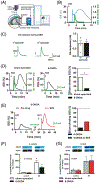Striatal spreading depolarization: Possible implication in levodopa-induced dyskinetic-like behavior
- PMID: 30759320
- PMCID: PMC8006568
- DOI: 10.1002/mds.27632
Striatal spreading depolarization: Possible implication in levodopa-induced dyskinetic-like behavior
Abstract
Objective: Spreading depolarization (SD) is a transient self-propagating wave of neuronal and glial depolarization coupled with large membrane ionic changes and a subsequent depression of neuronal activity. Spreading depolarization in the cortex is implicated in migraine, stroke, and epilepsy. Conversely, spreading depolarization in the striatum, a brain structure deeply involved in motor control and in Parkinson's disease (PD) pathophysiology, has been poorly investigated.
Methods: We characterized the participation of glutamatergic and dopaminergic transmission in the induction of striatal spreading depolarization by using a novel approach combining optical imaging, measurements of endogenous DA levels, and pharmacological and molecular analyses.
Results: We found that striatal spreading depolarization requires the concomitant activation of D1-like DA and N-methyl-d-aspartate receptors, and it is reduced in experimental PD. Chronic l-dopa treatment, inducing dyskinesia in the parkinsonian condition, increases the occurrence and speed of propagation of striatal spreading depolarization, which has a direct impact on one of the signaling pathways downstream from the activation of D1 receptors.
Conclusion: Striatal spreading depolarization might contribute to abnormal basal ganglia activity in the dyskinetic condition and represents a possible therapeutic target. © 2019 International Parkinson and Movement Disorder Society.
Keywords: D1 like receptor; LIDs; Parkinson's disease; Spreading depolarization; Striatum.
© 2019 International Parkinson and Movement Disorder Society.
Figures





Similar articles
-
Modulation of serotonergic transmission by eltoprazine in L-DOPA-induced dyskinesia: Behavioral, molecular, and synaptic mechanisms.Neurobiol Dis. 2016 Feb;86:140-53. doi: 10.1016/j.nbd.2015.11.022. Epub 2015 Nov 27. Neurobiol Dis. 2016. PMID: 26639853
-
Stronger Dopamine D1 Receptor-Mediated Neurotransmission in Dyskinesia.Mol Neurobiol. 2015 Dec;52(3):1408-1420. doi: 10.1007/s12035-014-8936-x. Epub 2014 Oct 26. Mol Neurobiol. 2015. PMID: 25344317
-
Synaptic plasticity and levodopa-induced dyskinesia: electrophysiological and structural abnormalities.J Neural Transm (Vienna). 2018 Aug;125(8):1263-1271. doi: 10.1007/s00702-018-1864-6. Epub 2018 Feb 28. J Neural Transm (Vienna). 2018. PMID: 29492662 Review.
-
Derangement of Ras-guanine nucleotide-releasing factor 1 (Ras-GRF1) and extracellular signal-regulated kinase (ERK) dependent striatal plasticity in L-DOPA-induced dyskinesia.Biol Psychiatry. 2015 Jan 15;77(2):106-15. doi: 10.1016/j.biopsych.2014.04.002. Epub 2014 Apr 12. Biol Psychiatry. 2015. PMID: 24844602
-
Direct and indirect striatal efferent pathways are differentially influenced by low and high dyskinetic drugs: behavioural and biochemical evidence.Parkinsonism Relat Disord. 2008;14 Suppl 2:S165-8. doi: 10.1016/j.parkreldis.2008.04.023. Epub 2008 Jun 25. Parkinsonism Relat Disord. 2008. PMID: 18583175 Review.
Cited by
-
Spreading depolarizations pose critical energy challenges in acute brain injury.J Neurochem. 2024 May;168(5):868-887. doi: 10.1111/jnc.15966. Epub 2023 Oct 3. J Neurochem. 2024. PMID: 37787065 Free PMC article. Review.
-
Neuropathology and pathogenesis of extrapyramidal movement disorders: a critical update-I. Hypokinetic-rigid movement disorders.J Neural Transm (Vienna). 2019 Aug;126(8):933-995. doi: 10.1007/s00702-019-02028-6. Epub 2019 Jun 18. J Neural Transm (Vienna). 2019. PMID: 31214855 Review.
-
Paroxysmal Genetic Movement Disorders and Epilepsy.Front Neurol. 2021 Mar 23;12:648031. doi: 10.3389/fneur.2021.648031. eCollection 2021. Front Neurol. 2021. PMID: 33833732 Free PMC article. Review.
-
Behavioral and Cognitive Consequences of Spreading Depolarizations: A Translational Scoping Review.J Neurotrauma. 2025 Jan;42(1-2):1-18. doi: 10.1089/neu.2024.0118. Epub 2024 Oct 22. J Neurotrauma. 2025. PMID: 39494515
References
-
- Leao AA, Morrison RS. Propagation of spreading cortical depression. J Neurophysiol 1945;8:33–45.
-
- Pietrobon D, Moskowitz MA. Chaos and commotion in the wake of cortical spreading depression and spreading depolarizations. Nat Rev Neurosci 2014;15(6):379–393. - PubMed
-
- Mayevsky A, Doron A, Manor T, Meilin S, Zarchin N, Ouaknine GE. Cortical spreading depression recorded from the human brain using a multiparametric monitoring system. Brain Res 1996;740(1-2):268–274. - PubMed
Publication types
MeSH terms
Substances
Supplementary concepts
Grants and funding
LinkOut - more resources
Full Text Sources

